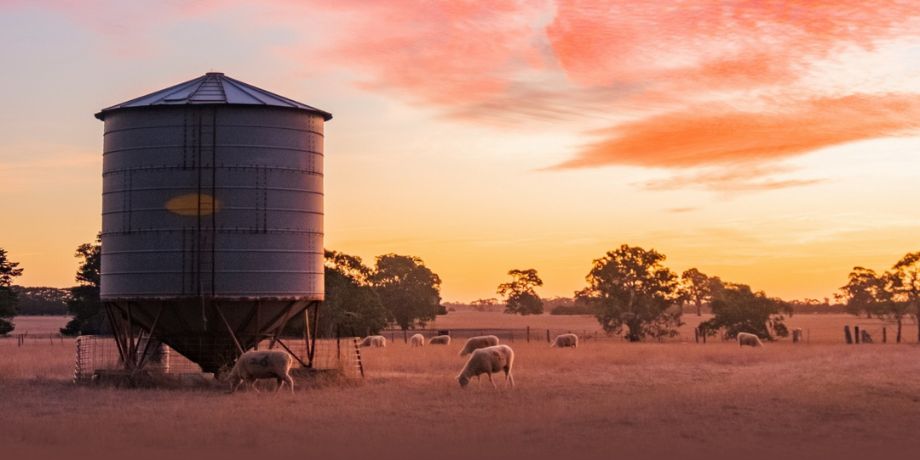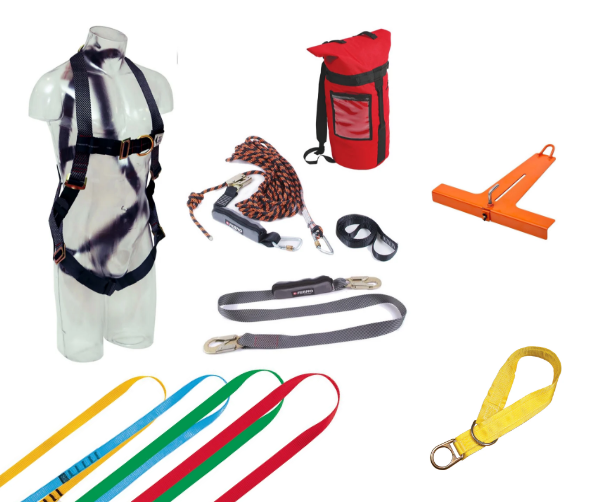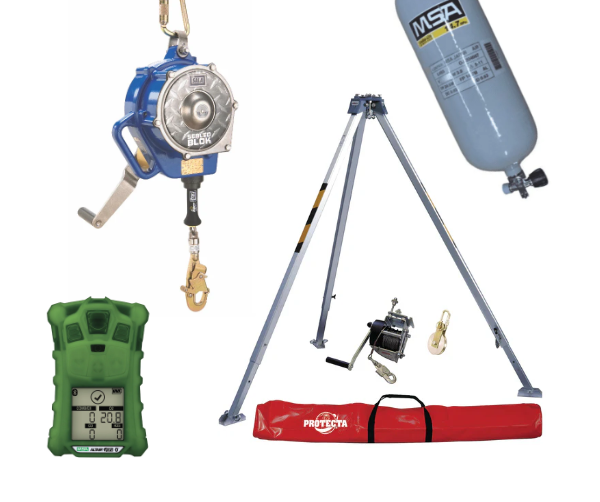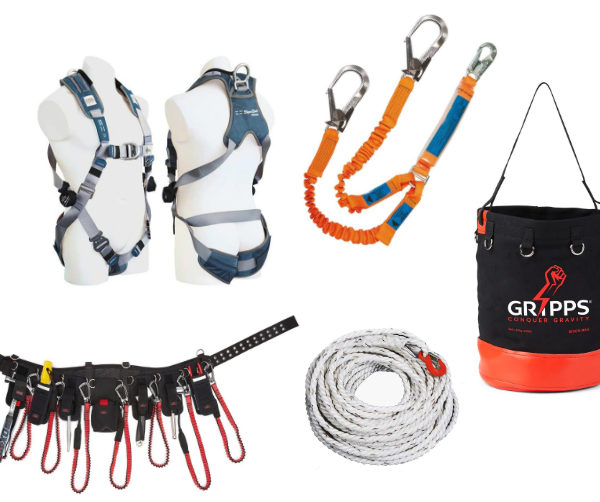
All farm work is hard work. All farm work is dawn till dusk, roll your sleeves up, get it done work. But not all farm work carries the same level of risk. As soon as you’re doing any work at height (or in a confined space) the risk profile changes. So here are our top tips for staying safe and for mitigating height safety hazards while performing elevated tasks around your farm.
Know your work-at-height hot spots – and gear up
Identifying your work-at-height hot spots and stocking up on suitable specialist equipment for any high-risk activities is crucial. Where these are and what exactly you require will depend on your property, land and buildings – but below are some typical examples.
![]()
Roof Work
Working on the roof of a warehouse, barn or storage facility is high-risk due to potential falls off the edge of the roof (or through it if the roof is fragile). Look for an off-the-shelf or custom Roofers Kit that suits your site. Be sure to add a suitable temporary anchor (eg tether plate, beam anchor, anchor sling). Shop: Roof Work Collection, Temporary Anchors, Anchor Slings

![]()
Ladder Work
Ladders are easy to use but also easy to fall off. Be sure to stabilise yours at ground level and secure it to the side of your structure or the gutter of your roof. On sites where ladder work is frequent, consider installing a permanent ladder safety system. For extra safety, hook-up to an overhead fall arrest system (via a retractable lanyard) if possible. Shop: Vertical Ladder Systems, Brackets and Stabilisers, Retractable Lanyards

![]()
Grain Silos, Water Tanks
You will need specialist confined space equipment if you need to enter your grain silo or water tank for any reason (ie to clean it). An off-the-shelf or customised Confined Space Kit (ie winch, harness, fall protection, tripod) is a good place to start. Gas Detection and Self-Contained Breathing Kits are also crucial for confined spaces. Shop: Confined Space Kits, Davits and Tripods, Type 3 Retrieval Devices and Winches, Gas Detection Kits, Self-Contained Breathing Apparatus

![]()
Tree Work
Working at height in orchards, whether pruning or harvesting, involves the risk of falls from height and/or of being hit by falling branches. So get the gear professionals use such as an arborist’s harness, flexible climbing line, positioning lanyards, pulleys, platform ladders and carabiners. Shop: Arborists Collection

![]()
Scaffolding
Using scaffolding for adhoc tasks around the farm isn’t uncommon, but you should never improvise when it comes to height safety. You may well need fall protection and scaffolding essentials such as lanyards with scaffold hooks and suitable tool tethers, tool belts or tool bags. Shop: Scaffolders Collection

Golden rules for fall-proofing elevated farm work
In 2022, falls from height and/or being hit by a falling object accounted for 18% of all workplace fatalities according to SafeWork Australia. That’s why it’s so important to follow these golden rules for work-at-height:
- Eliminate hazards and reduce risks upfront
- Always use specialist height safety equipment
- Take extra care in confined spaces
- Never work-at-height alone
1. Eliminate hazards and reduce risks upfront
Use our 4-tier Hierarchy of Control system to eliminate hazards and reduce risks before your feet leave the ground. It will help you focus on fall prevention first, which is your best line of defence. You could potentially eliminate or avoid height safety hazards altogether. Or at least substantively reduce your risk exposure via engineering controls.
For the risks that remain, your last and crucial line of defence is fall protection. This includes the height safety PPE (harness, lanyard, connector, helmet etc) that protects you and connects you to a height safety system and/or the structure you’re working on. It’s job is to catch you – and minimise any impacts – if you should fall.
2. Always use specialist height safety equipment
Whatever work-at-height you need to get done, using the right and best height safety equipment to keep you safe on the job is mission critical. Which is why you should always hire or buy specialist height safety equipment from a height safety specialist.
A height safety specialist has the product range, knowledge, skills and experience to ensure you get gear that meets your specific needs, application and worksite. In the case of Height Dynamics, that experience extends to almost 25 years working on-site and/or supplying height safety solutions and products to clients right across Australia.
Your height safety specialist can also advise you on application and correct use of your height safety equipment. This is an important point, as specialist height safety equipment can only keep you safe if you know how to use it. Given Australia’s Workplace Manslaughter Laws, it’s also important to invest in basic height safety training across your workforce.
3. Take extra care in confined spaces
Confined spaces are difficult to access, exit and work in – and can quickly become hazardous and toxic environments. That’s why it’s so important to identify any confined spaces on your property (see Four key characteristics of a confined space). Common examples around the farm would be water tanks or grain silos.
If you do have to work in a confined space, take extreme care. Do not enter unless you have a robust plan for evacuation if the worst should happen. This includes having people who can assist you from outside the space. This latter point is very important – anyone who needs to enter a confined space to rescue you may also become endangered. In a worst-case scenario, this can lead to multiple tragedies.
Before entering any confined space – always have a spotter posted outside and a clear entry and exit point with a safe access system set up (tripod, retrieval winch, etc). Once inside the space – you’ll need specialist confined space equipment (for oxygen and toxic gas detection), suitable fall arrest equipment and PPE, plus a rescue kit.
Concerned about your confined space? This is one job you might want to outsource. Our on-site services include setting up a safe access/exit system and completing work inside the space as directed. Alternatively, we can set up, support and supervise your team whilst doing the work – and be their standby rescue crew. Talk to our Confined Space team
4. Never work-at-height alone
Last but not least, never work alone. Working alone at height is not a good idea in any setting, but especially on a farm. Changing weather patterns can bring exposure to high winds, rain, hail or dense fog – all of which can quickly transform your elevated worksite into a trip, slip and fall hazard. And if you drop your phone or aren’t able to reach your height safety access system and return to the ground safely, you could end up stranded.
If you do happen to fall – even with a fall arrest system and PPE in place to save your life – the stakes are even higher. Getting to the ground quickly after a fall can be the difference between life and death due to the impact of suspension trauma on your body. But if you’re working alone without a spotter, you’ll have no-one to rescue you if you’re unconscious or unable to move.
